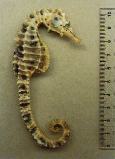| Hippocampus abdominalis Lesson, 1827 | ||||
| Family: | Syngnathidae (Pipefishes and seahorses) , subfamily: Hippocampinae | picture
(Hiabd_f0.jpg) by
Lourie, S.A.
Map |
||
| Order: | Syngnathiformes (pipefishes and seahorses) | |||
| Class: | Actinopterygii (ray-finned fishes) | |||
| name: | Pot-bellied seahorse | |||
| Max. size: | 32.0 cm Total Length(male/unsexed; Ref. 30915) | |||
| Environment: | demersal; non-migratory; brackish; marine ; depth range 0 - 40 m | |||
| Climate: | temperate; 30°S - 47°S | |||
| Importance: | fisheries: of no interest; aquarium: commercial | |||
| Resilience: | Medium, minimum population doubling time 1.4 - 4.4 years (Preliminary K and tmax.) | |||
| Distribution: Gazetteer |
Southwest Pacific: Australia and New Zealand. Vulnerable (Ref. 30915). Occurrence in Thailand and the Philippines (Ref. 43081) needs verification. | |||
| Diagnosis: | Dorsal spines (total): 0-0; Dorsal soft rays (total): 25-31; Anal spines: 0-0; Anal soft rays: 4-4. Description: (based on 17 specimens): Adult height: 8.0-32.0 cm; Rings: 12-13 + 47 (45-48) Snout length: 2.6 (2.2-3.2) in head length; Dorsal fin rays: 27-28 (25-29) covering 4+1 rings; Pectoral fin rays: 15-17; Caudal fin absent; Coronet: low, triangular wedge; Spines: low, rounded bumps only. Other distinctive characters: (very) prominent rounded eye spines; often with thick fronds attached to head region; very deep body with keel (especially females); mature males have extremely prominent (usually white) brood pouch. Color pattern: pale, near white to mottled yellow to variable brown; dark spots and splotches on head and trunk; tail with alternating dark and light bands; dorsal fin mottled; males have more dark blotches than females and commonly have a yellow slash near the top of the pouch 34. | |||
| Biology: | Found in large rock pools at low tide. They remain motionless amidst seaweed. Juveniles are pelagic (Ref. 30915) or attached to drifting seaweeds (Ref. 31838). Feed on minute crustaceans (e.g. copepods and amphipods). Nocturnal (Ref. 9003). Seen in groups at night. Also around jetties and other man-made objects; attached to sponges and colonial hydroids in deeper water (Ref. 30915). Length measurements refer to height (= TL - head length). This is the largest seahorse species in southeastern Australia, and has more dorsal fin rays and tail rings than any other seahorse (Ref. 31838). Sold locally and internationally for the aquarium trade (Ref. 31838). Dried and sold to the Oriental medicine trade as a tonic and aphrodisiac (Ref. 5316, 34026). | |||
| Red List Status: | Vulnerable, see IUCN Red List (A2d) , Vincent, A. , (Ref. 36508) | |||
| Dangerous: | harmless | |||
| Coordinator: | ||||
| Main Ref: | Lourie, S.A., A.C.J. Vincent and H.J. Hall. 1999. (Ref. 30915) | |||
|
Update | Add | Get XML file | Point data in XML | Common names in XML |
||||